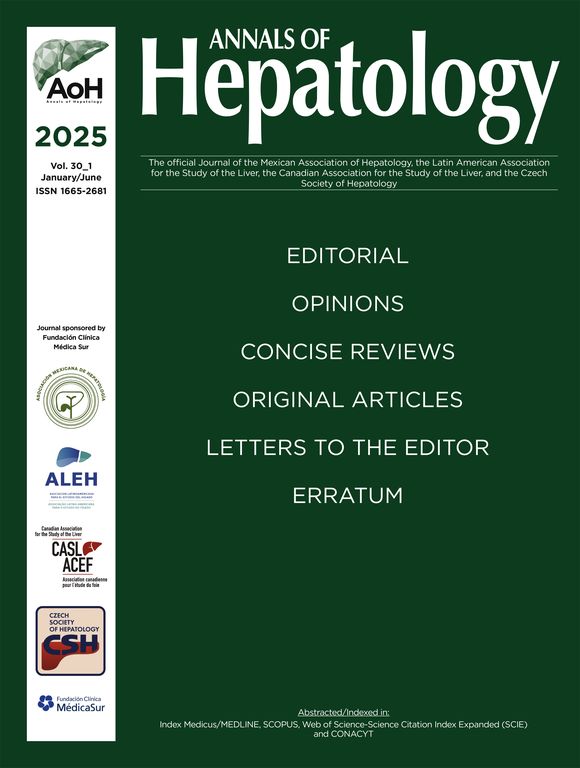
Abstracts of the 2024 Annual Meeting of the ALEH
Más datosYes, Laboratorio Gador financió los tests rápidos.
Introduction and ObjectivesHepatitis B (HBV) and C (HCV) viruses are one of the main causes of morbidity and mortality worldwide. Their epidemiology in Chile is not completely known, with an estimated prevalence of 0.034-0.15% for HBV and 0.1-0.19% for HCV. Although, in Chile, there is a wide coverage and availability of antiviral treatments, the main barrier to achieve the elimination of these viruses is the lack of knowledge of the serological condition. Objectives: To stablish the prevalence of HBV and HCV infection in the population at risk in Chile.
Patients / Materials and MethodsCross-sectional, multicenter study, with participation of 8 Chilean health centers. HBV/HCV rapid tests (CTK-BIOTECH) were applied in people aged 18 years-old or older with at least 1 risk factor. Demographic and clinical data were collected using REDCap®. Statistical analysis was performed using Stata 16.0 software.
Results and DiscussionA total of 806 patients were included in the analysis, mean age was 44.6 ± 15.1 years and 53.6% were women. The main risk factors were: being in prison (22.5%), exposed health care personnel (16.9%) and obesity with steatotic liver disease (16.6%). Three patients tested positive for HBV and one patient had HBV/HCV coinfection. Seroprevalence of HBV and HCV infection was 0.49% and 0.12%, respectively. Two of the patients had coinfection with HIV. Serological confirmation to date was done in 3 of the 5 positive tests and confirmed the diagnosis in 3 of them (2 HBV and 1 HCV).
ConclusionsIn this preliminary study, the prevalence of HBV and HCV infection in the population at risk is low. Further patient recruitment is required to identify the population on which to focus screening efforts and other preventive public health measures.
Table 1. Clinical and demographic characteristics.
| Total N = 806 (%) | |
|---|---|
| Age, years (mean ± SD) | 44.6 ± 15.1 |
| Sex, n (%) | |
| Female | 432 (53.6) |
| Male | 367 (45.5) |
| No binary | 5 (0.6) |
| Non informed | 2 (0.2) |
| Residency region, n (%) | |
| Metropolitana de Santiago | 387 (48.0) |
| Los Ríos | 119 (14.8) |
| Arica y Parinacota | 101 (12.5) |
| Araucanía | 55 (6.8) |
| Atacama | 53 (6.6) |
| Biobío | 47 (5.8) |
| Maule | 13 (1.6) |
| Los Lagos | 9 (1.1) |
| Valparaíso | 8 (1.0) |
| Ñuble | 3 (0.4) |
| Coquimbo | 2 (0.2) |
| Libertador General Bernardo O'Higgins | 2 (0.2) |
| Magallanes y Antártica | 2 (0.2) |
| Tarapacá | 1 (0.1) |
| Antofagasta | 1 (0.1) |
| Aysén | 1 (0.1) |
| Native people, n (%) | 78 (9.7) |
| Alcohol consumption, n (%) | |
| Yes | 180 (22.3) |
| No | 503 (62.4) |
| Comorbidities, n (%) | |
| Steatotic liver disease | 165 (20.5) |
| Hypertension | 164 (20.3) |
| Insuline resistance | 97 (12.0) |
| Diabetes Mellitus | 69 (8.6) |
| Hypothyroidism | 44 (5.5) |
| Cirrhosis | 36 (4.5) |
| Chronic kidney disease | 7 (0.9) |
| Other | 147 (18.2) |
| HVB/HVC risk factors, n (%) | |
| Being in prison | 181 (22.5) |
| Exposed health-care personnel | 136 (16.9) |
| Obesity with steatotic liver disease | 134 (16.6) |
| Transaminase elevation | 120 (14.9) |
| HIV coinfection | 49 (6.1) |
| Alcoholic cirrhosis | 23 (2.9) |
| Pregnancy | 18 (2.2) |
| Blood donor | 17 (2.1) |
| Men who have sex with men | 14 (1.7) |
| Blood transfusion before 1996 | 10 (1.2) |
| Other | 380 (47.2) |









